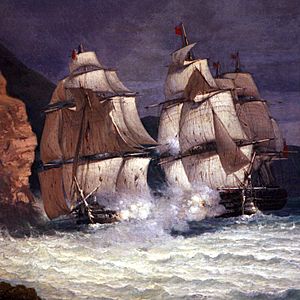Boyne-class ship of the line (1810) facts for kids

Fight of the Romulus against HMS Boyne and HMS Caledonia
|
|
Quick facts for kids Class overview |
|
|---|---|
| Name: | Boyne |
| Operators: | |
| Preceded by: | Neptune class |
| Succeeded by: | Rodney class |
| In service: | 3 July 1810 - 1861 |
| Completed: | 2 |
| General characteristics | |
| Type | Ship of the line |
| Length |
|
| Beam | 51 ft 5 in (15.67 m) |
| Propulsion | Sails |
| Armament |
|
| Notes | Ships in class include: Boyne, Union |
Imagine huge sailing warships that ruled the seas! The Boyne-class ships were two powerful ships of the line built for the Royal Navy in 1810. These impressive vessels were called "second-rate" ships because of their size and the number of guns they carried. They had 98 guns, making them very strong in battle.
What's really cool is that these ships were built using the same plans as the famous HMS Victory, which was Admiral Nelson's flagship at the Battle of Trafalgar. This meant they were designed to be tough and effective in naval warfare.
Meet the Ships: HMS Boyne and HMS Union
The Boyne-class included two main ships. Both were built in important dockyards in England.
HMS Boyne (1810)
- Builder: This ship was built at the Portsmouth Dockyard.
- Ordered: The order to build HMS Boyne was given on 25 June 1801.
- Launched: It slid into the water on 3 July 1810.
- Fate: After serving for many years, HMS Boyne was taken apart, or "broken up," in 1861.
HMS Union (1811)
- Builder: HMS Union was constructed at the Plymouth Dockyard.
- Ordered: The order for this ship was placed on 13 July 1801.
- Launched: It was launched on 15 November 1811.
- Fate: HMS Union was also broken up, but earlier, in 1833.

All content from Kiddle encyclopedia articles (including the article images and facts) can be freely used under Attribution-ShareAlike license, unless stated otherwise. Cite this article:
Boyne-class ship of the line (1810) Facts for Kids. Kiddle Encyclopedia.
